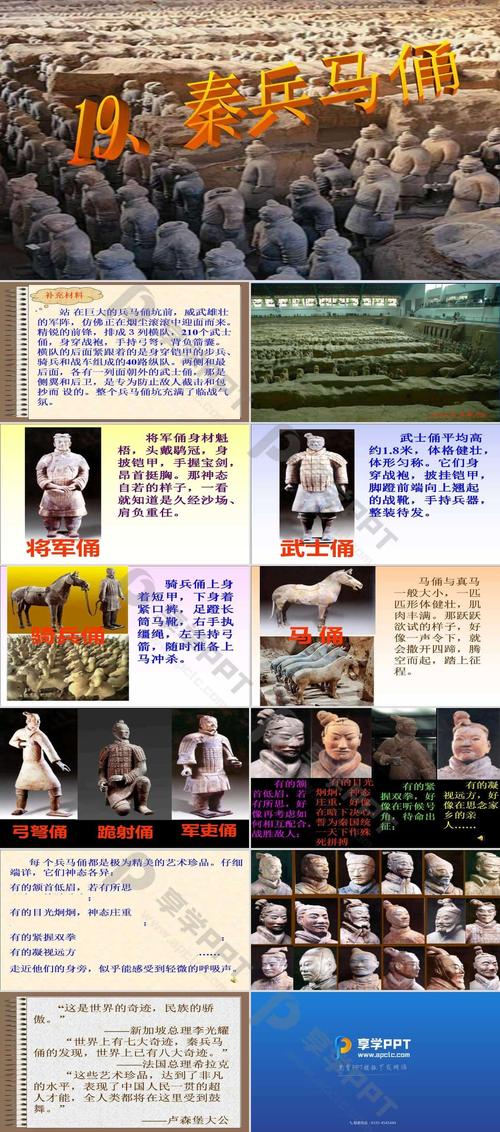
The Significance of the Terracotta Army
The Terracotta Army is one of the most remarkable archaeological discoveries of the 20th century. This vast collection of life-sized terracotta sculptures, depicting the armies of Qin Shi Huang, the first Emperor of China, is a testament to the power, artistry, and ambition of the Qin dynasty. But beyond its sheer scale and visual impact, the Terracotta Army holds immense historical significance, offering invaluable insights into ancient Chinese military organization, weaponry, and the reign of Qin Shi Huang himself.
Insights into Ancient Chinese Military Structure
The Terracotta Army provides a detailed glimpse into the military structure of the Qin army. The figures are arranged in distinct battle formations, showcasing the hierarchical organization of the army, with infantry, archers, charioteers, and cavalry all represented.
- Detailed Representations of Rank and Role: Each soldier's rank and role within the army are meticulously depicted through variations in their clothing, armor, hairstyles, and even facial expressions. Generals, easily identifiable by their elaborate armor and headgear, stand tall, overseeing ranks of foot soldiers armed with spears, swords, and crossbows. The presence of charioteers, complete with armored chariots and drivers, highlights the importance of chariots in ancient Chinese warfare.
- Diversity in the Ranks: Interestingly, the army boasts a diverse range of soldiers, potentially representing different regions within Qin Shi Huang's vast empire. The variations in facial features and physical builds among the terracotta warriors suggest the Qin army was comprised of soldiers from different ethnicities and backgrounds.
- Logistics and Scale: The sheer number of figures – estimated to be over 8,000 – speaks volumes about the scale of the Qin army and the logistical complexities of maintaining such a force. The production of the Terracotta Army itself, with its standardized yet unique figures, is a testament to the Qin dynasty's sophisticated organizational capabilities.
Weaponry of the Qin Dynasty
The Terracotta Army offers a rare glimpse into the weaponry and military technology of ancient China. The figures are depicted carrying a diverse arsenal of weapons, meticulously crafted from bronze and other materials.
- Advanced Weapon Construction: Examination of the weapons has revealed sophisticated manufacturing techniques. The bronze weapons, in particular, demonstrate a high level of craftsmanship. The discovery of chrome plating on some of the bronze weapons, a technology thought to have been developed much later, is evidence of the Qin dynasty's advanced metallurgical knowledge.
- Variety and Innovation: The Terracotta Army showcases the variety and innovation present in the Qin arsenal. We see crossbows with intricate bronze trigger mechanisms, long-range weapons that gave the Qin army a significant tactical advantage. The different types of swords, spears, and halberds reflect the diverse combat styles employed by the Qin soldiers.
- Insights into Military Tactics: The weapons, combined with the army's formation, offer clues about the Qin dynasty's military tactics and strategies. The presence of long-range weapons like crossbows suggests a focus on ranged combat, while the close-order formations of the infantry point to disciplined fighting techniques.
The Reign of Qin Shi Huang
The creation of the Terracotta Army itself is a testament to the power and ambition of Qin Shi Huang. The emperor, known for his ruthlessness and desire to achieve immortality, commissioned the creation of this massive necropolis to protect him in the afterlife.
- A Show of Power and Wealth: The scale of the project and the intricate detail of the figures reflect the immense wealth and resources at Qin Shi Huang's disposal. The Terracotta Army was not just an army for the afterlife; it was a statement of imperial might intended to awe and intimidate any potential enemies, even in death.
- Beliefs About the Afterlife: The Terracotta Army provides insights into the ancient Chinese beliefs about the afterlife. The practice of burying the emperor with an entire army reflects the belief that the afterlife mirrored the earthly realm. Qin Shi Huang, obsessed with maintaining his power even after death, sought to rule the afterlife with the same authority he wielded in life.
- Legacy of a Unified China: While Qin Shi Huang is remembered for his often-brutal rule, he is also credited with unifying China and establishing a centralized government. The Terracotta Army, while a product of his ambition, also stands as a symbol of the unified nation he created, a nation that would go on to become a major world power.
An Ongoing Legacy of Discovery
The Terracotta Army remains a site of active archaeological excavation, with new discoveries constantly adding to our understanding of the Qin dynasty and ancient China. This incredible site will continue to provide valuable historical insights for generations to come.
Q&A
1. Why was the Terracotta Army built?
The Terracotta Army was built to accompany Qin Shi Huang, the first Emperor of China, in the afterlife. It was believed that the emperor would need an army to protect and serve him in the next world.
2. What can we learn about ancient Chinese warfare from the Terracotta Army?
The Terracotta Army provides a wealth of information about ancient Chinese military organization, weaponry, and tactics. We can learn about the different types of soldiers in the Qin army, the weapons they used, and how they might have fought in battle.
3. Why is the Terracotta Army considered to be such an important archaeological discovery?
The Terracotta Army is an unparalleled archaeological treasure. Its scale, artistry, and the sheer volume of information it provides about ancient Chinese civilization make it one of the most significant archaeological discoveries of all time.